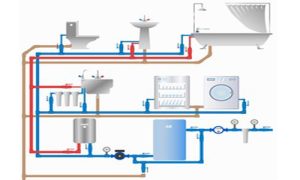
Key components and aspects of a water distribution system include:
The system begins with the collection of source water, which could be from surface water bodies like rivers, lakes, and reservoirs, or from groundwater wells. Effective source water management, including monitoring water quality and protecting water sources from contamination, is vital to ensure a safe and reliable water
Before distribution, the collected water often undergoes treatment processes such as filtration, disinfection, and chemical treatment to remove contaminants and pathogens. These treatments make the water safe for consumption and minimize health risks.
The distribution network consists of a vast network of pipes of varying sizes and materials. These pipes transport the treated water from the treatment plants to homes, businesses, and other establishments. Proper pipe material selection, installation, and maintenance are critical to prevent leaks, breaks, and contamination.
Pumping stations are strategically located along the distribution network to maintain adequate pressure and flow rates, ensuring that water reaches all parts of the system. Pumps are used to overcome elevation differences and provide the necessary momentum for water movement.
Valves are essential components that allow for control of water flow, pressure regulation, and isolation of different sections of the distribution network for maintenance or repairs. Advanced control devices and monitoring systems help manage the system efficiently.
Storage tanks and reservoirs serve as buffer storage, helping to balance supply and demand fluctuations throughout the day. They provide a reserve of water during peak usage periods, emergencies, or maintenance activities.
Regular water quality monitoring is conducted at various points within the distribution system to ensure that the water remains safe and complies with regulatory standards. This monitoring helps identify any potential issues and allows for timely corrective actions.
Hydraulic modeling software is often employed to simulate the behavior of the distribution system under different conditions. This helps optimize the design, identify potential bottlenecks, and plan for system expansions or improvements.
Ongoing maintenance, repair, and rehabilitation are essential to extend the lifespan of the distribution system and prevent leaks, breaks, and other failures. Scheduled flushing, cleaning, and pipe replacement are common practices to maintain system integrity.
Water distribution systems must have contingency plans in place for emergencies such as pipe breaks, water main failures, or natural disasters. Having procedures for quick response and communication ensures minimal disruption to water supply and public safety.
In conclusion, a well-designed and properly managed water distribution system is vital for ensuring access to safe and reliable drinking water for communities. It requires careful planning, regular maintenance, advanced technology, and adherence to water quality standards to deliver this essential resource to homes and businesses while safeguarding public health and the environment.
Please feel free to contact us. We will get back to you with 1-2 business days. Or just call us now
WhatsApp us
